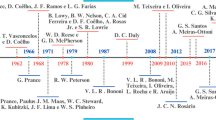Abstract
The surface and internal tissues of the fruiting bodies of basidiomycetes were shown to be specific bacterial habitats characterized by varying diversity and structure of bacterial complexes. On the surface of fruiting bodies, gram-negative bacteria of the genera Pseudomonas, Xanthomonas, and Myxococcus prevailed, while in the internal tissues gram-positive bacteria of the genera Streptomyces, Bacillus, Arthrobacter, and Micrococcus were identified in addition. Bacterial complexes from the surface and inner tissues of the fruiting bodies of the studied basidiomycetes showed significant similarity to each other and differed from those from the hyphosphere and the reference soil. On the surface and in the internal tissues of the fruiting bodies, representatives of the genus Myxococcus were identified for the first time, which could indicate initial decay of the fruiting body.
Similar content being viewed by others
References
Bergey’s Manual of Determinative Bacteriology, 9th ed., Holt, J.G., Krieg, N.R., Sneath, P.H.A., Staley, J.T., and Williams, S.T., Eds., Baltimore: Williams and Wilkins, 1993.
De Boer, W., Folman, L.B., Summerbell, R.C., and Boddy, L., Living in a fungal world: impact of fungi on soil bacterial niche development, FEMS Microbiol. Rev., 2005, vol. 29, pp. 795–811.
Curl, E.A. and Truelove, B., The Rhizosphere, Berlin: Springer-Verlag, 1986.
Dahm, H. and Wrotniak, W., Detected proteolytic and chitinolytic activity of the pseudomonads isolated from inside the sporocarps of C. cibarius, Bull. Pol. Acad. Biol. Sci., vol. 3, pp. 167–175.
Dahm, H., Wrotniak, W., Strzelczyk, E., et al., Diversity of culturable bacteria associated with fruiting bodies of ectomycorrhizal fungi, Phytopathol. Pol., 2005, vol. 38, pp. 51–62.
Dobrovol’skaya, T.G., Struktura bakterial’nykh soobshchestv pochv (Structure of Soil Bacterial Communities), Moscow: Akademkniga, 2002.
Filippi, C., Bagnoli, G., Citernesi, A.S., and Giovannetti, M., Ultrastructural spatial distribution of bacteria associated with sporocarps of Glomus mosseae, Symbiosis, 1998, vol. 24, pp. 1–12.
Frey-Klett, P. and Garbaye, J., Mycorrhiza helper bacteria: a promising model for the genomic analysis of fungal-bacterial interactions, N. Phytol., 2005, vol. 168, pp. 4–8.
Gazzanelli, G., Malatesta, M., Pianetti, A., et al., Bacteria associated to fruit bodies of ectomycorrhizal fungus tuber Borchii vittad, Symbiosis, 1999, vol. 26, pp. 211–222.
Ivanov, Yu.Yu., Vapusan-Forte—a new drug with a customary name, Med. Sestra, 2008, no. 3, pp. 39–40.
Krasil’nikov, N.A., Mikroorganizmy pochvy i vysshie rasteniya (Soil Microorganisms and Higher Plants), Moscow: Izd. AN SSSR, 1958.
Lysak, L.V., Dobrovol’skaya, T.G., and Skvortsova, I.N., Metody otsenki bakterial’nogo raznoobraziya i identifikatsii pochvennykh bakterii (Methods of Assessment of Bacterial Diversity and Identification of Soil Bacteria), Moscow: MAKS-Press, 2003.
Lysak, L.V., The bacterial community of urban soils, Extended Abstract of Doctoral (Biol.) Dissertation, Moscow: Mosk. Gos. Univ., 2010.
Manucharova, N.A., Identifikatsiya metabolicheski aktivnykh kletok prokariot v pochvakh s primeneniem molekulyarno-biologicheskogo flyuorestsentnomikroskopicheskogo metoda analiza fluorescence in situ hybridization (FISH) (Identification of Metabolically Active Prokaryotic Cells in Soils Using Molecular-Biological Fluorescence Microscopy Analysis—Fluorescence in situ Hybridization (FISH)), Moscow: Izd. Mosk. Gos. Univ., 2008.
Rangel-Castro, J.I., Levenfors, J.J., and Danell, E., Physiological and genetic characterization of fluorescent Pseudomonas associated with Cantharellus cibarius, Can. J. Microbiol., 2002, vol. 48, pp. 739–748.
Tsukamoto, T., Murata, H., and Shirata, A., Identification of nonpseudomonad bacteria from bodied of wild Agaricales fungi that detoxify tolaasin produced by Pseudomonas tolaasii, Biosci. Biotechnol. Biochem., 2002, vol. 66, no. 10, pp. 2201–2208.
Varese, G.C., Portinaro, S., Trotta, A., et al., Bacteria associated with Suillus grevillei sporocarps and ectomycorrhizae and their effects on in vitro growth of mycobiont, Symbiosis, 1996, vol. 21, pp. 129–147.
Velikanov, L.L., Agaricales s.l. as edificators and stabilizer of soil-inhabiting microorganisms in forest communities, in 10th Congr. of Eur. Mycol. Abstr., Tallinn, 1989, p. 132.
Velikanov, L.L., The role of fungi in the formation of myco- and microbiota of soils of natural and disturbed biocenoses and agroecosystems, Extended Abstract of Doctoral (Biol.) Dissertation, Moscow: Mosk. Gos. Univ., 1997.
Velikanov, L.L. and Sidorova, I.I., Regulation by higher basidiomycetes of the structure of myco- and microbiota of soils and litter in forest ecosystems. I. Effect of basidiomycetes on the abundnance of fungi and bacteria, Mikol. Fitopatol., 1997, vol. 31, no. 4, pp. 20–26.
Velikanov, L.L. and Sidorova, I.I., Regulation by higher basidiomycetes of the structure of myco- and microbiota of soils and litter in forest ecosystems. II. Effect of Basidiomycetes on the species diversity of soil micromycetes, Mikol. Fitopatol., 1998, vol. 32, no. 1, pp. 33–36.
Velikanov, L.L. and Sidorova, I.I., The role of fungi in the formation of myco- and soil microbiota of natural biocenoses, Tr. Zvenigorod. Biol. Stantsii, 2001, vol. 3, pp. 61–71.
Voronina, E.Yu., The abundance of soil-forming bacteria and micromycetes in the rhizosphere, hyphosphere, and mycorrhizosphere of symbiotrophic basidiomycetes, Mikol. Fitopatol., 2009, vol. 43, no. 5, pp. 398–406.
Voronina, E.Yu., Lysak, L.V., and Zagryadskaya, Yu.A., The quantity and structure of the saprotrophic bacterial complex of the mycorhizosphere and hyphosphere of symbiotrophic basidiomycetes, Biol. Bull., 2011, vol. 38, no. 6, pp. 622–628.
Warmink, J.A., Nazir, R., and van Elsas, J.D., Universal and species-specific bacterial “fungiphiles” in the mycospheres of different basidiomycetous fungi, Environ. Microbiol., 2009, vol. 11, no. 2, pp. 300–312.
Zagriadskaia, Yu.A., Lysak, L.V., Lapygina, E.V., et al., The characteristics of bacterial communities in the hyphosphere of several basidial macromycetes, Mosc. Univ. Soil Sci. Bull., 2011, vol. 66, no. 3, pp. 129–134.
Author information
Authors and Affiliations
Corresponding author
Additional information
Original Russian Text © Yu.A. Zagriadskaia, L.V. Lysak, I.I. Sidorova, A.V. Aleksandrova, E.Yu. Voronina, 2013, published in Izvestiya Akademii Nauk, Seriya Biologicheskaya, 2013, No. 4, pp. 405–411.
Rights and permissions
About this article
Cite this article
Zagriadskaia, Y.A., Lysak, L.V., Sidorova, I.I. et al. Bacterial complexes of the fruiting bodies and hyphosphere of certain basidiomycetes. Biol Bull Russ Acad Sci 40, 358–364 (2013). https://doi.org/10.1134/S106235901304016X
Received:
Published:
Issue Date:
DOI: https://doi.org/10.1134/S106235901304016X




